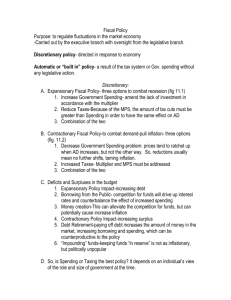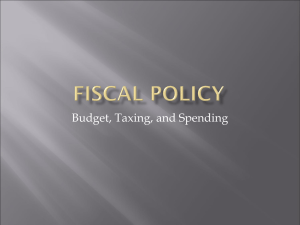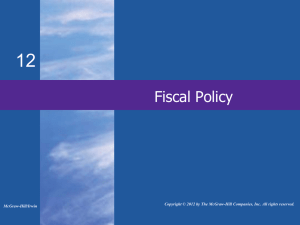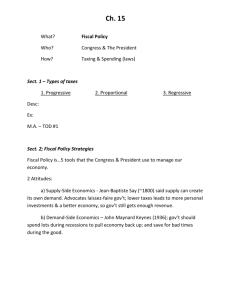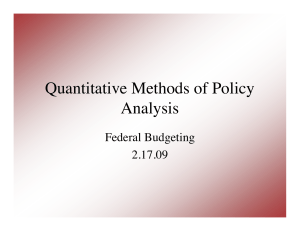Fiscal Policy
advertisement
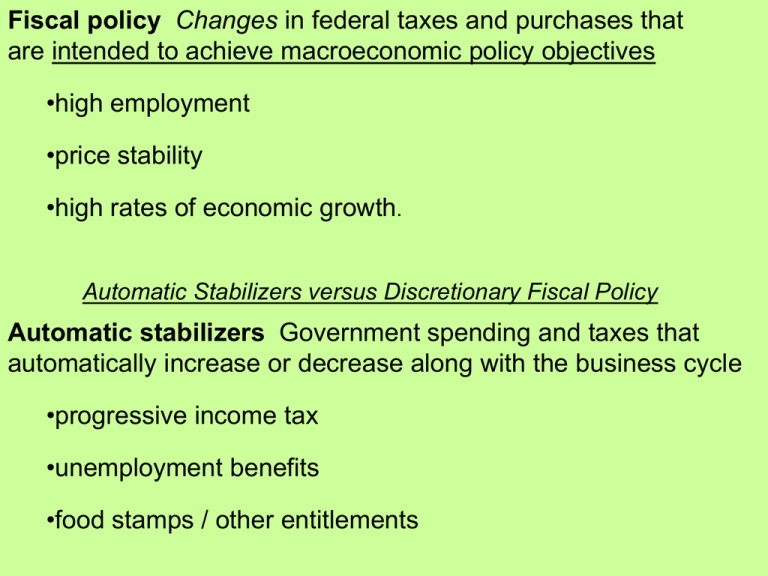
Fiscal policy Changes in federal taxes and purchases that are intended to achieve macroeconomic policy objectives •high employment •price stability •high rates of economic growth. Automatic Stabilizers versus Discretionary Fiscal Policy Automatic stabilizers Government spending and taxes that automatically increase or decrease along with the business cycle •progressive income tax •unemployment benefits •food stamps / other entitlements The Federal Government’s Share of Total Government Expenditures, 1929–2006 Federal Purchases and Federal Expenditures as a Percentage of GDP, 1950–2006 An Overview of Government Spending and Taxes Federal Government Expenditures, 2006 Federal Government Revenue, 2006 The Effects of Fiscal Policy on Real GDP and the Price Level Looks a lot like expansionary and contractionary monetary policy …except for impacts on interest rates and investment spending How Fiscal Policy Affects Aggregate Demand, Real GDP and the Price Level Countercyclical Fiscal Policy ACTIONS BY CONGRESS AND THE PRESIDENT RESULT PROBLEM TYPE OF POLICY Recession Expansionary Increase government spending or cut taxes Real GDP and the price level rise. Rising Inflation Contractionary Decrease government spending or raise taxes Real GDP and the price level fall. Don’t Let This Happen to YOU! Don’t Confuse Fiscal Policy and Monetary Policy! Government Purchase and Tax Multipliers The Multiplier Effect and Aggregate Demand Government Purchase Multiplier The Multiplier Effect of an Increase in Government Purchases This spending multiplier is analogous but not the same as the deposit multiplier The Government Tax Multiplier A cut in tax rates affects equilibrium real GDP in two ways: (1) disposable income rises consumption spending rises (2) the rate at which purchasing power leaks from the spending stream declines the spending multiplier increases The less the marginal propensity to leak, the greater the spending multiplier. Recall: Spending Multiplier = 1/[Marginal Propensity to Leak] = 1/[Propensity Not to Respend Additional Income Domestically] =1/[Propensity to pay taxes, save and buy things from abroad] The Government Purchases and Tax Multipliers Taking into Account the Effects of Aggregate Supply Because the Price Level rises, Real GDP does not increase as much as it otherwise would The multiplier effect is reduced The Limits of Using Fiscal Policy Crowding out A decline in private expenditures as a to Stabilize the Economy result of an increase in government purchases. Money market An Expansionary Fiscal Policy Increases Interest Rates The Limits of Using Fiscal Policy to Stabilize the Economy Crowding Out in the Short Run Deficits, Surpluses, and Federal Government Debt The Federal Budget Deficit, 1901–2006 Cyclically adjusted budget deficit or surplus The deficit or surplus in the federal government’s budget if the economy were at potential GDP. Making the Connection Did Fiscal Policy Fail during the Great Depression? FEDERAL GOVERNMENT EXPENDITURES (BILLIONS OF DOLLARS Although government spending increased during the Great Depression, the cyclically adjusted budget was in surplus most years. ACTUALFEDERAL BUDGET DEFICIT OR SURPLUS (BILLIONS OF DOLLARS) CYCLICALLY ADJUSTED BUDGET DEFICIT OR SURPLUS (BILLIONS OF DOLLARS) CYCLICALLY ADJUSTED BUDGET DEFICIT OR SURPLUS AS A PERCENTAGE OF GDP 1929 $2.6 $1.0 $1.24 1.20% 1930 2.7 0.2 0.81 0.89 1931 4.0 -2.1 -0.41 -0.54 1932 3.0 -1.3 0.50 0.85 1933 3.4 -0.9 1.06 1.88 1934 5.5 -2.2 0.09 0.14 1935 5.6 -1.9 0.54 0.74 1936 7.8 -3.2 0.47 0.56 1937 6.4 0.2 2.55 2.77 1938 7.3 -1.3 2.47 2.87 1939 8.4 -2.1 2.00 2.17 Deficits, Surpluses, and Federal Government Debt The Federal Government Debt: Is it a problem? Vicious circle: Deficit Debt i Interest expense Deficit The Effects of Fiscal Policy in the Long Run Tax wedge The difference between the pre-tax and post-tax return to an economic activity. Disincentive to work??? Impacts of supply-side tax cuts • Individual income tax. • Corporate income tax. • Taxes on dividends and capital gains: double taxation. Tax Simplification: A flat–tax??? —pros and cons The Effects of Fiscal Policy in the Long Run The Economic Effect of “Supply Side” Tax Reform Key Terms Automatic stabilizers Budget deficit Budget surplus Crowding out Cyclically adjusted budget deficit or surplus Fiscal policy Multiplier effect Tax wedge

